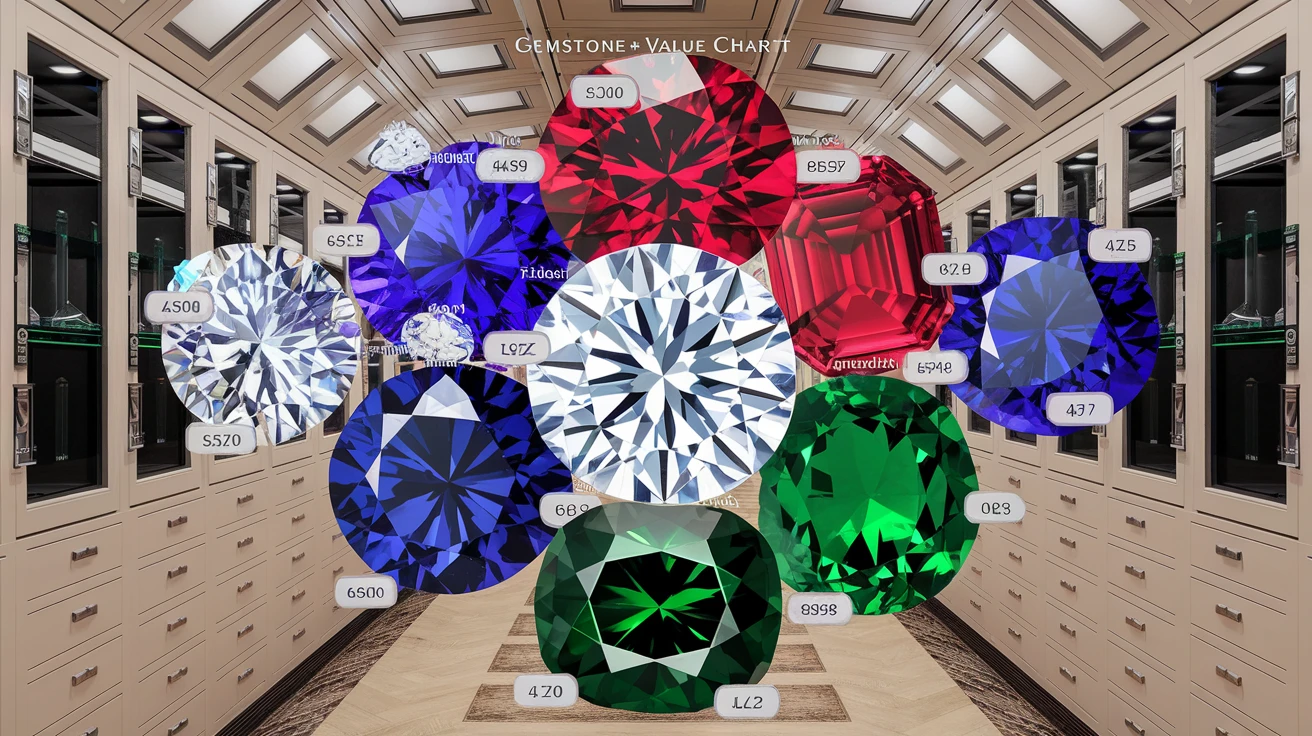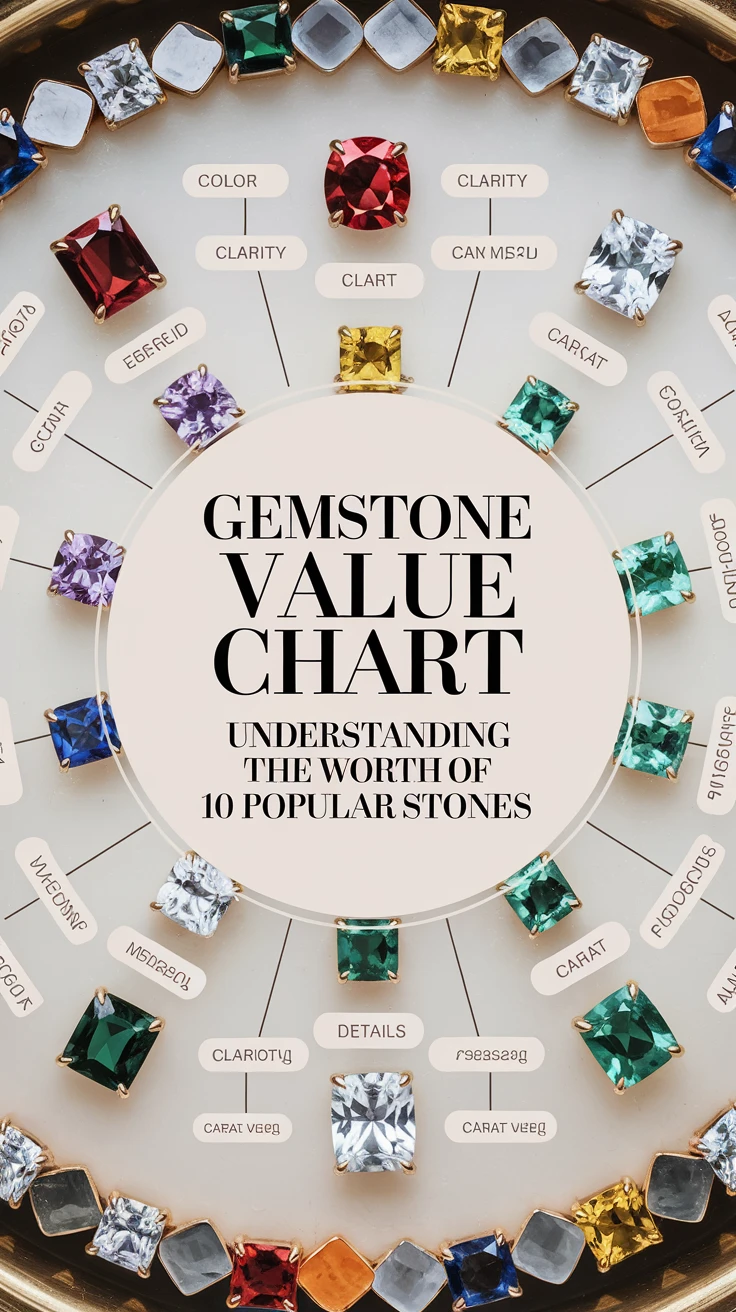
When it comes to the fascinating world of gemstones, understanding their value is both an art and a science. As someone who’s spent countless hours at gem shows and dealing with collectors, I’ve learned that the worth of these precious stones goes far beyond their sparkling appearance. Whether you’re a potential investor, a jewelry enthusiast, or simply curious about the value of your family heirlooms, this comprehensive guide will help you understand what makes certain gemstones more valuable than others and how to assess their worth accurately.
Understanding Gemstone Value: More Than Just Beauty
The value of a gemstone isn’t just about its beauty or size. Having witnessed numerous transactions and evaluations, I can tell you that several critical factors determine a stone’s worth. Here are the primary elements that influence gemstone value:
-
– Color intensity and purity
– Clarity and transparency
– Cut quality and precision
– Carat weight
– Rarity in nature
– Market demand
– Historical significance
– Certification and origin
– Treatment status
– Current market trends
Each of these factors plays a crucial role in determining the final value of a gemstone. I remember attending a gem show where two seemingly identical sapphires had a price difference of over $10,000 – all because one was naturally colored while the other had undergone heat treatment.
Top 10 Popular Gemstones and Their Value Charts
| Gemstone | Price Range Per Carat | Value Factors | Investment Potential |
|---|---|---|---|
| Diamond | $1,000 – $100,000+ | 4Cs (Cut, Color, Clarity, Carat) | High |
| Ruby | $100 – $15,000+ | Origin, Color, Clarity | Very High |
| Sapphire | $50 – $10,000+ | Color, Origin, Treatment | High |
| Emerald | $200 – $18,000+ | Clarity, Color, Origin | Moderate to High |
| Tanzanite | $50 – $1,000+ | Color, Size, Clarity | Moderate |
| Alexandrite | $500 – $20,000+ | Color Change, Origin | Very High |
| Opal | $50 – $10,000+ | Play of Color, Pattern | Moderate |
| Tourmaline | $50 – $1,000+ | Color, Clarity, Size | Moderate |
| Morganite | $100 – $300+ | Size, Color, Clarity | Low to Moderate |
| Aquamarine | $30 – $500+ | Color, Clarity, Size | Moderate |
Let’s explore each gemstone in detail:
1. Diamond
The king of gemstones, diamonds remain the most valued and sought-after precious stones. Their value is primarily determined by the famous 4Cs: Cut, Color, Clarity, and Carat weight. A high-quality one-carat diamond can easily fetch upwards of $15,000.
2. Ruby
Fine rubies, especially those from Burma (Myanmar), can be more valuable than diamonds. The most prized colors are “pigeon blood red” rubies, which can command astronomical prices per carat.
3. Sapphire
While blue is the most famous color, sapphires come in various hues except red. Kashmir sapphires are particularly valuable due to their rarity and unique “cornflower blue” color.
4. Emerald
Colombian emeralds are considered the finest, with their deep green color and garden-like inclusions. Unlike diamonds, slight inclusions in emeralds are acceptable and expected.
5. Tanzanite
A relatively modern discovery, tanzanite’s value comes from its limited source – it’s found only in Tanzania. Its striking blue-violet color makes it increasingly popular.
6. Alexandrite
This rare color-changing gem can be worth more per carat than diamonds. Fine specimens change from green in daylight to red in incandescent light.
7. Opal
Australian opals are particularly valuable, with black opals commanding the highest prices. The play of color and pattern significantly influence value.
8. Tourmaline
ParaÃba tourmalines, with their electric blue color, are the most valuable variety, sometimes reaching tens of thousands per carat.
9. Morganite
This pink beryl has gained popularity in recent years, particularly for engagement rings, though it remains relatively affordable.
10. Aquamarine
The deeper the blue, the more valuable the aquamarine. Large stones are relatively common, making per-carat prices lower than many other precious gems.
Factors Affecting Gemstone Quality and Value
| Quality Grade | Characteristics | Value Multiplier |
|---|---|---|
| Heirloom | Perfect color, clarity, and cut | 5-10x base value |
| Fine | Excellent color, minimal inclusions | 3-5x base value |
| Good | Good color, visible inclusions | 1-2x base value |
| Commercial | Average quality, obvious inclusions | 0.5-1x base value |
The most important factors to consider when evaluating gemstone quality are:
– Color: Intensity, tone, and hue uniformity
– Clarity: Presence and visibility of inclusions
– Cut: Precision, symmetry, and polish
– Carat Weight: Size relative to gemstone type
– Origin: Source location and mining method
– Treatment: Natural vs. enhanced characteristics
Expert Tips for Gemstone Buying
Drawing from years of experience and countless conversations with gem dealers, here are essential tips for making smart gemstone purchases:
-
– Always obtain certification from reputable laboratories
– Research current market prices before making purchases
– Examine stones under different lighting conditions
– Consider the stone’s treatment history
– Buy from reputable dealers with solid track records
– Keep documentation of your purchase
– Understand the maintenance requirements
– Consider insurance for valuable pieces
Conclusion
Understanding gemstone values is crucial for both collectors and investors. While the market can be complex, armed with the right knowledge about quality factors, current trends, and proper evaluation techniques, you can make informed decisions about gemstone purchases. Remember that value isn’t just about the initial price – it’s about long-term appreciation potential and the joy these beautiful stones bring to their owners.
Key Takeaways
- Gemstone value is determined by multiple factors, with color, clarity, and rarity being primary considerations
- Each gemstone type has unique value factors that affect its worth
- Certification and documentation are crucial for valuable stones
- Market trends and origin significantly impact gemstone values
- Professional assessment is essential for accurate valuation
Frequently Asked Questions
How often do gemstone values change?
Gemstone values can fluctuate monthly or yearly based on market demand, new discoveries, and global economic conditions. It’s important to stay updated with current market trends.
Are treated gemstones worth less than natural ones?
Generally, yes. Natural, untreated gemstones typically command higher prices than treated stones of similar appearance, though treatments are common and accepted in the market.
What certificates should I look for when buying gemstones?
Look for certificates from internationally recognized laboratories like GIA, AGL, or SSEF. These provide the most reliable and respected gemstone evaluations.
Can gemstone values appreciate over time?
Yes, particularly rare and high-quality stones often appreciate in value. However, like any investment, returns aren’t guaranteed and depend on market conditions.
How do I know if I’m paying a fair price for a gemstone?
Research current market prices, get multiple opinions from reputable dealers, and always request certification for valuable stones. Price comparison across several dealers is recommended.
Are larger gemstones always more valuable?
Not necessarily. Quality factors like color and clarity often matter more than size. A smaller, higher-quality stone may be worth more than a larger, lower-quality one.
How does origin affect gemstone value?
Certain origins are associated with superior quality or historical significance. For example, Kashmir sapphires and Colombian emeralds typically command premium prices.
Should I buy gemstones as an investment?
While gemstones can be good investments, they should be part of a diversified portfolio. Knowledge, patience, and expert guidance are essential for successful gemstone investing.
How can I protect the value of my gemstones?
Store them properly, maintain insurance, keep all documentation, and have them professionally cleaned and inspected periodically.
What’s the best way to sell valuable gemstones?
Work with reputable dealers or auction houses, obtain current appraisals, and maintain all original documentation. Consider multiple offers before selling.

